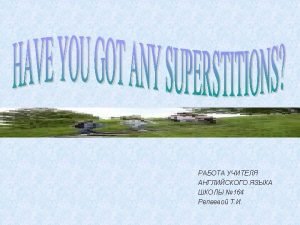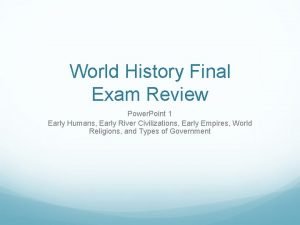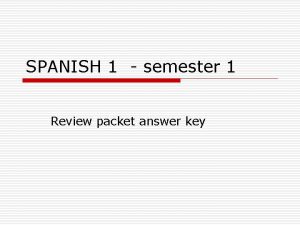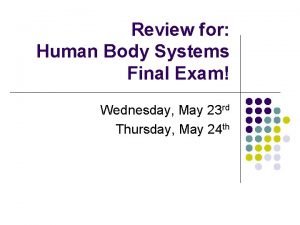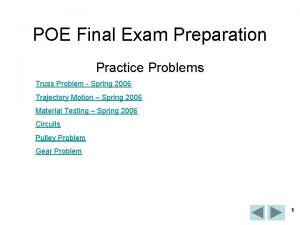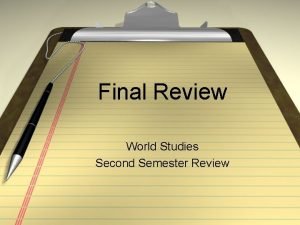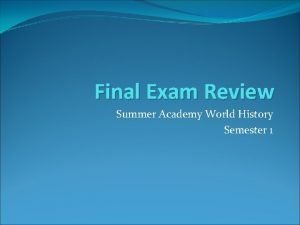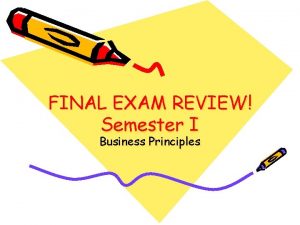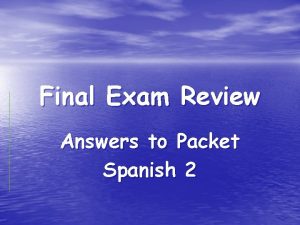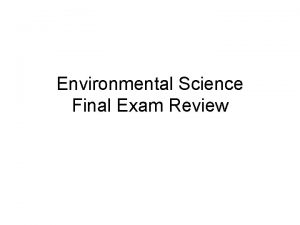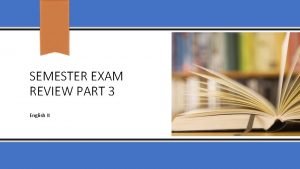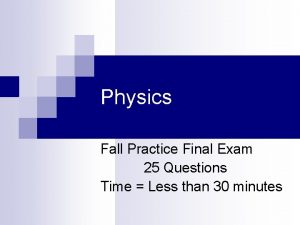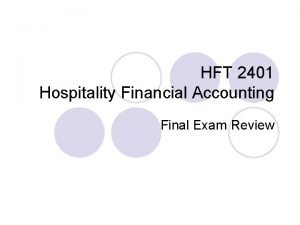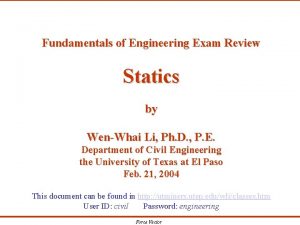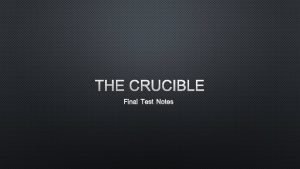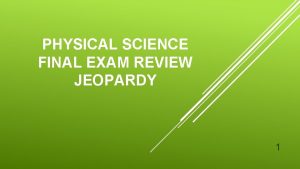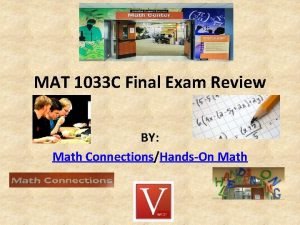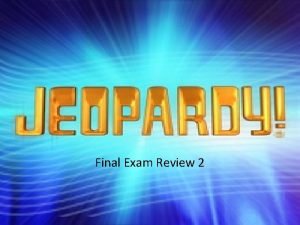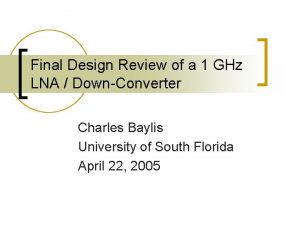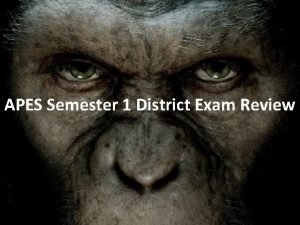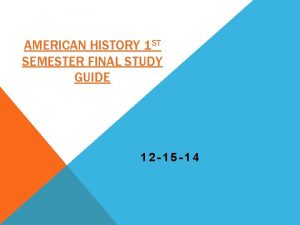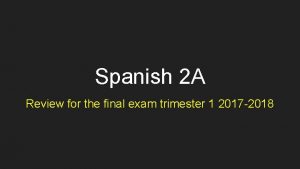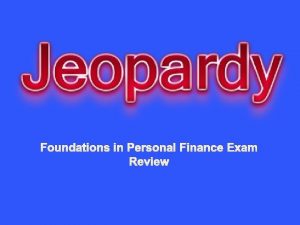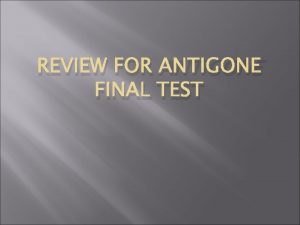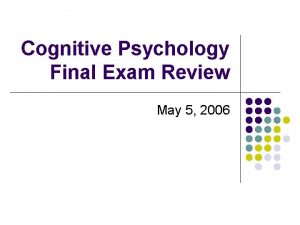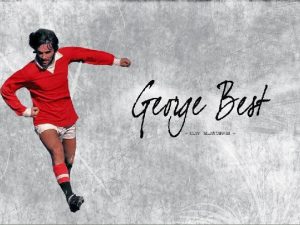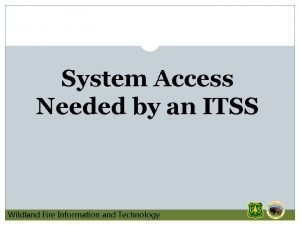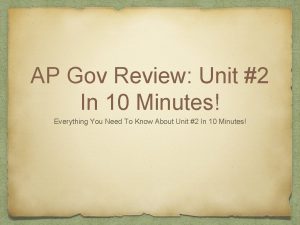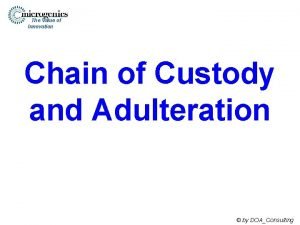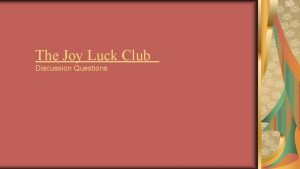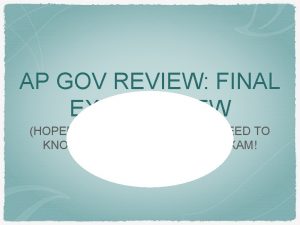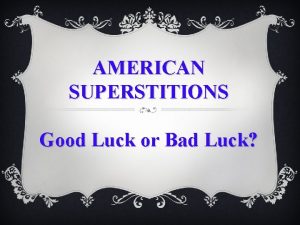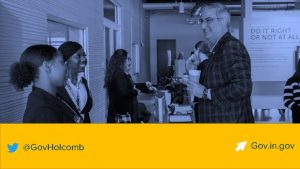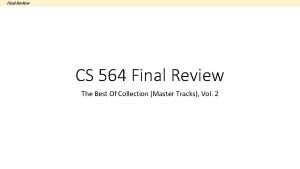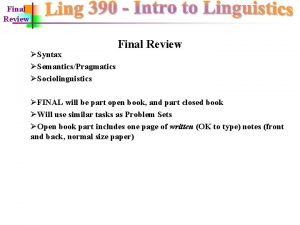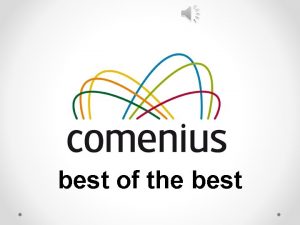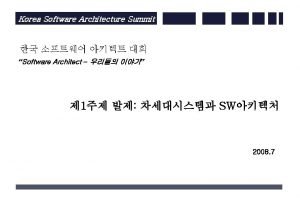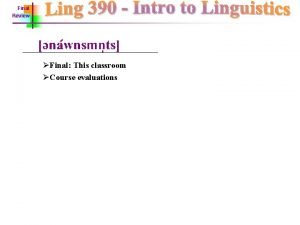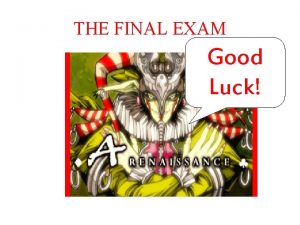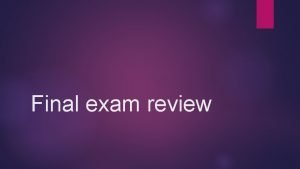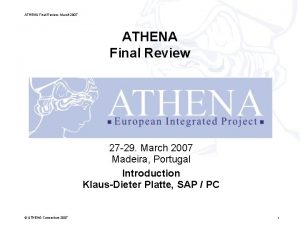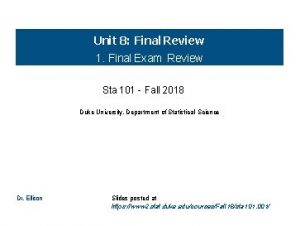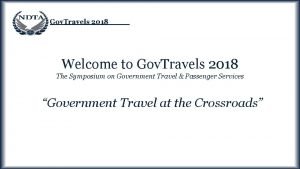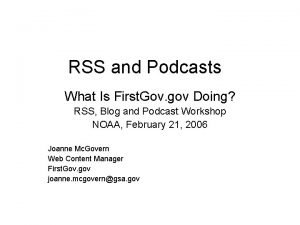AP GOV REVIEW FINAL Best of luck on

AP GOV REVIEW: FINAL Best of luck on the exam. EXAM REVIEW You are brilliant and will (HOPEFULLY) do EVERYTHING great. You are. YOU NEED TO KNOW TOALWAYS SUCCEED ON YOUR EXAM! more than a test score. Don’t forget that.

Constitution Influences of the Constitution: Enlightenment - John Locke and Montesquieu Articles of Confederation - very weak central government Shays’ Rebellion - demonstrated the weakness of the Articles - strong government needed to keep order Separation of Powers: Montesquieu Divides responsibility between branches Examples - Congress declares war and creates laws, President is commander in chief and enforces laws Wall of Separation: Separation of Church and State

Checks and Balances Purpose? To keep one branch from becoming too powerful KNOW examples of Checks and Balances It MUST involve two branches For example: The Supreme Court overturning a lower court decision is NOT an example Congress impeaching the President IS an example The Senate can confirm a Supreme Court Justice with a Simple Majority (51) The Supreme Court CANNOT declare an amendment unconstitutional If Congress disagrees with a court decision, the only solution is to create an amendment

What is it? Federalism Division of power between federal (national) and state governments 10 th amendment - powers not given to the national government are reserved for states Elastic Clause - allows the federal government to make laws that are “necessary and proper” Often, the federal government and states share powers - Cooperative Federalism (law enforcement) Devolution - giving power back to state governments (Reagan) Grants: Categorical: Project - based on application Formula - $ is distributed based on a formula (Medicaid) Block - $ is given with discretion to states with how to spend States would favor Block grants Mandates - requirements for states by the federal government Examples - Americans with Disabilities Act Federalism can lead to diverse policies throughout the US (education, gun laws, etc. )

Misc. Constitution Primary Responsibility? Protecting private property Voting: Voting requirements are left to states Development of poll taxes and literacy tests in the South Citizens directly vote ONLY for House members and Senators (after the 17 th amendment) Electoral College elects the president Commerce Clause - regulate commerce with foreign nations and states Increased the power of the federal government over time Amending the Constitution: Involves both the national government and states (Federal structure of government)

Theories of Government And Ratification Pluralism - belief that groups can influence public policy through organizations (NRA, NOW, UAW) Elitism - belief that society is separated between wealthy (elites) and non-wealthy; wealthy make decisions in politics Hyperpluralism -belief that there are too many groups competing that government is weakened as a result Federalists and Anti-federalists: Debated over the size and scope of the national government Federalist #10: Factions and controlling factions Factions are undesirable, but inevitable

Electoral College What is it? It’s what elects the president In 48 states, the candidate that wins the popular vote wins ALL the electoral votes Implications of the Electoral College? Large (population) and swing states get most attention If no one receives a majority of electoral votes (270), then the House decides the election, with each state getting 1 vote Encourages a two-party system

Elections Primaries: Open - Voters are NOT required to register with a party to vote in a primary Closed - Only voters registered with a party can vote in a primary Majority Election: Candidate must receive more than half the votes (Electoral College is an example 270 votes needed) Plurality Election: A candidate can without receiving a majority, rather they receive the MOST vote Can happen when more than two candidates run Popular votes in 1860, 1968, and 1992 In recent years, we have frequently had a DIVIDED GOVERNMENT: Congress and the Presidency are controlled by different parties

Political Parties No mention in the Constitution Parties have national, state, and local offices - often separate and independent In recent years, more and more Americans identify with neither party

Interest Groups What are they? Groups that seek to influence public policy Examples? NRA, AARP, NEA, etc. How do they influence public policy? Lobbying, litigation, provide legislators with key information, etc. How are interest groups different from political parties? They do NOT nominate candidates Interest groups and political parties are LINKAGE INSTITUTIONS Link the public to the political process Other linkage institutions include: media, elections, and political parties

Political Action Committees (PACs) What are they? Committee that donates money to a candidate and political party $5, 000 per candidate, per election (1 for primary, 1 for general) Individuals CANNOT donate more than $5, 000 to a PAC per year Who do PACs donate money to? Candidates that are favorable to their issues

Political Socialization and Beliefs What is socialization? How individuals learn about politics What is the most common form? FAMILY! Many Americans support equality, but NOT economic equality More Americans distrust the government since the 1960 s

Political Behavior Young people (under 30) do NOT typically vote in large numbers Even after lowering the voting age to 18 (26 th amendment), 18 -21 year olds still voted less than others The older an individual is, and the more educated, the more likely they are to vote African Americans tend to vote Democratic Beginning in 1968, and continuing through today (especially 1980 s), most Southern whites vote Republican Party identification plays a SIGNIFICANT role in how an individual will vote in a Presidential election and Congressional elections Ticket-Splitting: Voting for both parties during elections for different offices Has increased in recent years

Political Participation and Public Opinion The most common form of political participation is voting in presidential elections MOST Americans do NOT vote in most elections Lower turnout than other democracies Political Efficacy - the belief that an individual can make an impact on the political process

Media And “Iron Triangles” Most media outlets focus on day-to-day activities of presidential candidates, not necessarily the issues In recent years, media outlets have been controlled by fewer companies Fewer companies control and decide the news “Horse-race journalism” - media focus on polls, rather than issues What is an “iron triangle? ” Congress, Interest Groups, and Bureaucracy (government agencies)

Congress Legislation is long, difficult to pass, and relies often on compromises Most bills NEVER become law, much less get to the whole Congress Incumbency: House incumbents overwhelmingly win elections HUGE predictor of election outcome Important in Senate elections, but NOT as important as House elections They receive more contributions, use the franking privilege, can cite services provided to constituents (serving on important committees to their areas - Iowa - Agriculture

Congress Continued Congress can declare war, appropriate $ - how they can oversee government agencies (bureaucracy), create new courts/more judges, override presidential vetoes (2/3 of both houses) Often, Congress allows the President to take the lead in foreign policy areas Congressional Oversight: Congress reviews an agency, department, or office Examples: Setting guidelines for agencies Hold hearings Allocate funding

Congressional Committees are more significant in the House More members - committees can do more work than the whole House Standing Committees Permanent committees - foreign relations or agriculture Members of committees tend to be experts in that area Conference Committee Helps settle differences between bills passed in both houses Rules Committee: (House of Reps) Determines the rules for bills - date, time for debates, amendments Closed rule - set time limits, no amendments allowed Open rule - looser time limits, amendments are allowed

Congressional Committees Subcommittees: Created by committees to investigate/research a specific issue and report back to the whole committee $ $$$$ Committee Chairs have become less influential in recent years In the House - members of the majority party Ways and Means (House): Economic committee - taxation, tariffs, etc. If a member serves on this committee, they CANNOT serve on another

House Of Representatives Special Powers: Impeach officials Revenue bills MUST start in the House 435 members - based on population Districts are determined by STATE LEGISLATURES Gerrymandering - drawing Congressional boundaries that are favorable to party in control Rules of procedure are more formal in the House than Senate “Closed rule” for a bill: Amendments CANNOT be added Speaker of the House: INCREDIBLY powerful - 3 rd in line for the presidency

Senate Special powers: Approve presidential appointments and treaties Jury in an impeachment trial 100 members - 2 per state “Cloture Motion” Can end a filibuster - bring a bill to a vote Senators have significant influence over bills - filibuster

How Elected Officials Vote Delegate - Congress votes according to how the majority of their constituents feel about an issue Trustee - Elected officials use their own views, or is based on the public good, not necessarily on the views of the constituents

The Executive Branch The president is elected by the Electoral College and serves a 4 year term 22 nd amendment - limits the president to 2 terms Presidential powers: Appoints judges (must be approved by the Senate) Commander-in-chief - deploy troops without consent of Congress (more in a bit) Veto bills (checks and balances) Veto Less than 10% of all vetoes are overridden The threat of a veto can be powerful in influencing legislation Vetoes are held up most often when the president’s party is in control of Congress Pocket Veto - President does nothing to a bill for 10 days when Congress is adjourned, bill does NOT become a law (Lincoln and the Wade-Davis bill) President is head of the political party through custom and tradition

The Executive Branch Executive Orders - do NOT need to be passed by Congress Presidents have used more frequently in recent years Executive orders/agreements may be dependent on Congressional funding Bill: Presidential Nomination Convention: Delegates nominate the president 1. part 1 of bill 2. part 2 of bill 3. part 3 of bill Delegates tend to be more ideological than the general population Powers NOT given to the President: Line-item veto (many governors can, but not president) Declaring war Creating new cabinet positions/departments - Congress

The Executive Branch Presidential Staff: White House Staff - loyal and supportive of the president National Security Advisor - Chief advisor to the President on national security issues Chief of Staff - does NOT require confirmation - can be fired at will Attorney General - leader of the Justice Department Inherent powers: Powers that the president has that are NOT explicitly stated in Constitution, but are inferred Examples - recognizing other governments, immigration, acquiring territory Cabinet members sometimes are torn between their department and the president

The Executive Branch Over time (especially after WWII), the president has gained more power: Cold War and foreign policy issues Government services for individuals Economic and domestic issues - Americans look to the president to rectify

The Executive Branch And Congress The President can try to influence legislation Using the media - Bully Pulpit President uses media more effectively than other branches Using their political party if they have a majority in Congress If the president is popular

The Executive Branch And The Judicial Branch The president can appoint judges What influences a president to appoint a certain judge? Usually, the president agrees with the judge’s philosophy

The Court System Supreme Court justices are appointed for life - why? Can be independent of political pressure - make unpopular decisions they deem right Appointed by the president, approved by the Senate (Checks and Balances) Most justices have a long track record PRIOR to being appointed Presidents know where they stand on issues A president can have a large impact after they are out of office based on appointments

The Court System Supreme Court Caseload The court can choose to hear almost any case it wishes Appellate courts are the most often source MOST court cases are NOT reviewed by the Supreme Court When 4 judges agree, the Court can hear a case District Court: Deal with most federal cases Most of these trials end in a plea bargain Appellate Court: Courts that can review decisions of district courts

Important Supreme Court Amicus Curiae - “friend of the court” Terms Allows interest groups to write letters to the court detailing how a case would impact them Doctrine of Original Intent: Looking at the Constitution based on the intention of the framers ***Incorporation Doctrine (Selective Incorporation): *** Applying most of the Bill of Rights to state governments (Mapp v. Ohio) State decisis Latin for “let the decision stand” The Supreme Court often makes decisions based on precedent, or previous decisions

Important Supreme Court Writs of certiorari: Terms Supreme Court orders a case from a lower court to be reviewed Judicial Restraint: Belief that the Supreme Court should rely on precedent in making decisions Advocates less Court involvement Judicial Activism: Belief that the Supreme Court can correct injustices (Brown v. Board) Supreme Court and Free Speech - free speech can be limited if it poses a “clear and present danger” - Schenck v. US Free Speech extends beyond use of words - flag burning, armband protests

Important Court Cases To Know Marbury v. Madison (1803) Established the principal of judicial review Court can overturn laws, executive orders, state laws, and lower court decisions Mc. Culloch v. Maryland (1819) - MD taxed a branch of the Bank of the US Supreme Court stated states could NOT tax a federal government agency Reinforced the elastic, or “necessary and proper clause” Power of the national government increased over the states Plessy v. Ferguson (1896): Supreme Court stated segregation was legal, as long as facilities were “equal” Later overturned by Brown v. Board

Important Court Cases To Know Miranda v. Arizona: Suspects must have their constitutional rights read to them 5 th amendment - right to remain silent during police interrogations Warren Court (1953 - 1969): Desegregated schools (Brown v. Board) Exclusionary rule (Mapp v. Ohio) (Selective Incorporation) Attorneys for individuals with low incomes (Gideon v. Wainwright) Miranda Warning (Miranda v. Arizona) Abortion was NOT part of the Warren Court (1973)

Important Court Cases To Know Griswold v. Connecticut (1965) - overturned a CT law prohibiting contraceptives Supreme Court argued the Constitution contained a right to privacy Roe v. Wade (1973) - Supreme Court overturned a TX law prohibiting abortion Both used the argument of a person’s right to privacy US v. Nixon (1974): Executive Privilege is not absolute Baker v. Carr (1962): “One person, one vote” State legislature districts have to be as close to equal as possible

Important Court Cases To Know Gitlow v. New York (1925): Court case that began SELECTIVE INCORPORATION New York Times v. Sullivan (1964): Public officials have to prove malice if trying to win a lawsuit for defamation Supreme Court and the death penalty: Not necessarily a violation of the 8 th amendment’s cruel and unusual punishment

Entitlements: Federal Budget Largest portion of uncontrollable spending Example? Social Security - baby boom generation is and will be drawing from Social Security Lower ratio people paying into Social Security today than when it began Office of Management and Budget (OMB): Prepare the federal budget What is a major predictor of funding for an agency? Last year’s budget

Bureaucracy Government agencies that implement policies EPA, FDA Receive mandates from Congress (and funding), then create guidelines to carry out those mandates Part of the “Iron Triangle”

Important Amendments To Know 1 st Amendment: Freedom of Religion, Press, Assembly, Petition, Speech Establishment clause - Congress shall not establish an official religion Free Exercise clause - Congress shall not prohibit the free exercise of religion 14 th amendment: Citizenship, equal protection ***SELECTIVE INCORPORATION***

Important Amendments To Know Democracy - related amendments: 15 - Suffrage for adult males 17 - Direct election of US senators 19 - Women’s suffrage 23 - 3 electoral votes for D. C. 24 - Elimination of poll taxes 26 - Voting age lowered to 18

Important Acts To Know Civil Rights Act of 1964: Guaranteed equal access to public accommodations Government could cut off funds where discrimination occurred Voting Rights Act of 1965: Federal government could register voters Eliminated literacy tests for voting War Powers Act: Limited the president’s ability to commit troops to conflict President must notify Congress within 48 hours of sending troops Must withdraw forces after 60 days unless Congress approves extension Motor Voter Laws: Voter registration opportunities must be provided when applying/renewing a license

Important Terms To Know Coalition Building: Groups coming together to achieve a goal Divided Government: Congress is controlled by a political party that the president is NOT a member of Also can include the House and Senate being controlled by different parties Impacts of divided government? Compromise is more difficult Increase in gridlock and things not getting done Frustration/increased distrust with government Divided government has been more frequent since the 1970 s

Important Terms To Know Civil Rights: Protect individuals/groups from discrimination Example? Civil Rights Act of 1964 Civil Liberties: Protect individuals from government actions Example? Bill of Rights

Important Elections 1796 - 2012 Kidding, kind of Election of 1932 - FDR and the New Deal Political realignment - African Americans, Jews, and working class began to vote predominantly Democratic Election of 1968 - Nixon Political realignment - Southern states (whites) began to vote Republican Election of 1980 - Reagan Continued political realignment Increase in Conservative Christians supporting the Republicans

Thanks For Watching! Best of luck! You’re more than a test score
- Slides: 45

